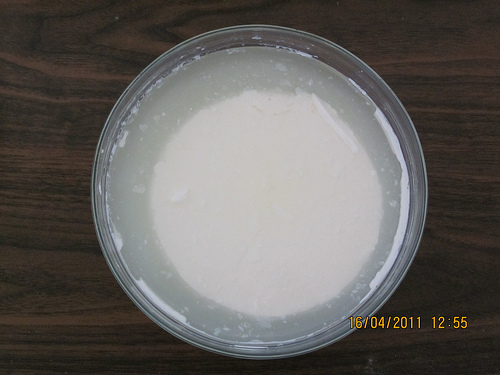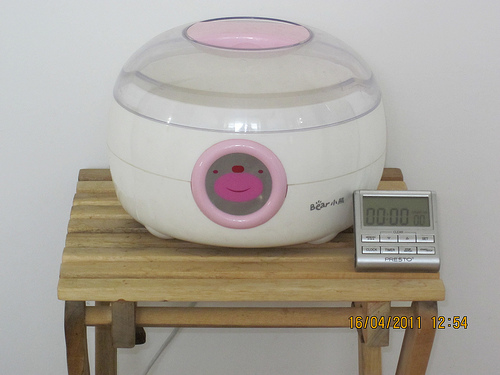I’ve made yogurt a few hundred times, mostly with a yogurt maker (picture below). The usual recipe is 1 quart milk, 1/4 teaspoon whey (from previous batch), incubate 24 hours. Yesterday, after incubation finished, I opened the machine to find this:

The milk (now yogurt) had squeezed together to form a perfectly round disc a few inches thick. It had squeezed out all the whey. The only unusual feature of this batch — besides the fact that it is getting warm and relatively humid here in Beijing — is that I used maybe 10% less milk than usual. This difference means the pulling inward force was less resisted by sticking to the sides, so this outcome indeed was more likely than usual.
This is my yogurt maker.

I bought it because it came with a glass bowl. Most yogurt makers have only a plastic bowl. You simply pour the milk in the glass bowl, add the starter (whey), add hot (boiling) water around the glass bowl, and wait a day — infinitely easier than the insanely complicated yogurt recipes I find on the Web. And I am beginning to think the hot water is unnecessary.
Does this require raw milk?
no. I used regular milk — an expensive Chinese brand.
Did the yogurt disk taste okay?
yeah, the yogurt disk tasted fine. Texture of crumbly cheese cake.
Cute yogurt maker Seth.
You probably already saw Paul Jaminet’s post on how things that threaten potential pathogen infections upregulate HDL, and how HDL plays a key role in the immune system.
It made me immediately think of your theories about fermented foods improving the immune response. Do you think the mechanism might be fermented foods signaling the body to make more HDL?
Caleb, I doubt it’s that simple. I believe fermented foods — more specifically, the bacteria they contain — cause the immune system to become more active. When it becomes more active lots of things happen. I now eat far more fermented foods than I ate several years ago but my HDL isn’t much different.
1/4 teaspoon of whey seems like a tiny amount for a quart of milk – I use much more than that, but maybe I’m using an unnecessarily large amount.
Seagull, I tested smaller and smaller amounts and got better and better results. Better in the sense that the final product was more uniform. Smooth, not lumpy. With less starter, I suppose you need a longer incubation time.